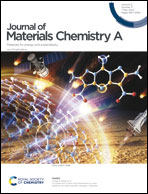Ab initio investigation of tunable CO2 reduction reaction on the two dimensional ferroelectric Y2CO2†
Abstract
The catalytic reduction of CO2 to value-added fuels is a promising way to eliminate greenhouse gas emissions, but the development of efficient catalysts is hampered by limiting scaling relationships between various intermediates. Recently, the use of ferroelectric materials has been proposed to overcome this, as switching the spontaneous electric polarization can alter the reactivity of the surface normal to it, allowing for the tunability of adsorption and binding strength of intermediates. In this work, we use density functional theory (DFT) calculations to investigate the photocatalytic CO2RR capabilities of a two-dimensional ferroelectric material with a solar optimal bandgap: the MXene Y2CO2. We investigated the reduction of CO2 to C1 products CO, formic acid, methanol, and methane. On an O-vacancy defected Y2CO2 surface, we find that the adsorption of CO2 is more preferable to CO on a poled up surface but less so on a poled down surface, resulting in selective adsorption of the two molecules. Second, we find that the energy of the COOH intermediate (leading to CO) is uphill on a poled up surface and downhill a poled down one, while the energy of the CHOO intermediate (leading to formic acid) is downhill on both. Finally, we demonstrate how the binding energy of all intermediates in the CO2 to CH3OH route is altered on poled up or poled down surfaces. The combination of atomically thin 2D layers, ferroelectricity, and an ideal band gap is therefore a promising route to achieving CO2 photoreduction.



 Please wait while we load your content...
Please wait while we load your content...